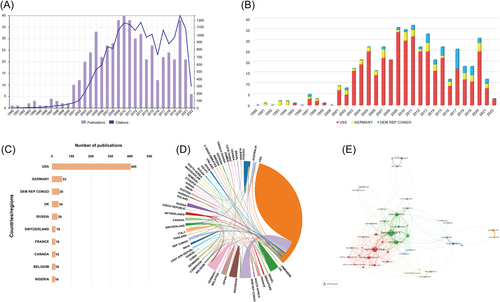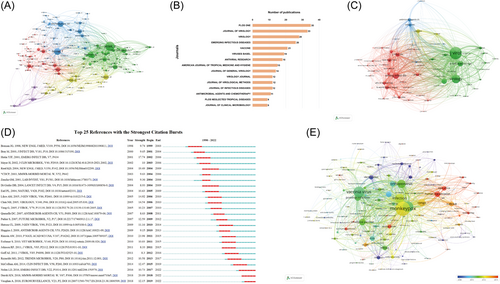Bibliometric analysis of global research trends on monkeypox: Are we ready to face this challenge?
Although the haze of the coronavirus 2019 (COVID-19) epidemic is still smothering the world, multiple cases of monkeypox reported within European and American countries have attracted scientific and public attention recently.1, 2 Monkeypox, is an emerging zoonotic disease caused by the monkeypox virus (MPXV), which belongs to the genus Orthopoxvirus in the family Poxviridae. Before 1970, MPXV was initially characterized as a nonhuman primate pathogen, until human monkeypox cases were reported in the Democratic Republic of Congo. The clinical features of human monkeypox were similar to smallpox and the case fatality rate for unvaccinated persons can be as high as 10%.3 In 2003, the United States had an outbreak of human monkeypox, representing the first confirmed incidence of human monkeypox outside Africa.4 Since then, the cumulative number of cases and geographical distribution of human monkeypox has been consistently increasing and research on this topic has been increasingly performed. Nevertheless, there is still a lack of one comprehensive report that could assist researchers to obtain an intuitive overview and understand the global research trends in the MPXV field.
Bibliometric analysis is a novel scientific method that integrates mathematical and statistical approaches with data visualization to determine the overall knowledge structure, development trends, and research priorities in a specific field.5 Although it has been widely used in medicine and health field, to our knowledge, a specific bibliometric analysis of MPXV research has not yet been performed. Therefore, in this study, three bibliometric tools, including VOSviewer and CiteSpace Software, and one online platform (https://bibliometric.com/) were used to conduct a bibliometric analysis of MPXV-related literature over the past few decades.
In our study, all the relevant studies on monkeypox were retrieved from the Web of Science Core Collection database on May 21, 2022. The scientific literature was searched based on titles, abstracts, and author keywords with the following terms “monkeypox” or “monkey pox.” Only literature published in English from 1990 to 2022 was included, and the document types were limited to original articles and reviews. After removing the duplicates manually, a total of 566 valid records including 492 articles and 74 reviews were obtained as the final data set for further bibliometric analysis (e.g., co-authorship, co-citation, and co-occurrence network/density visualization map). The cumulative number of citation frequency for all documents was 17 530 times with an average of 30.97 times per document. In addition, using a similar approach, we also downloaded several articles/reviews related to orthopoxvirus from 1990 to 2022 on May 25, 2022.
The specific distribution of annual publications and citations of monkeypox research was shown in Figure 1A. As is evident from this figure, the first research boom in this field started in the early 2000s, and the annual publications experienced fluctuating growth and reached a peak in 2010 (N = 40). This could be primarily related to the first outbreak outside Africa that occurred in the United States, which reported 47 patients with MPXV infection.4 However, after 2010, the annual publication showed a fluctuating downward trend, indicating that this important disease has been largely neglected in the past decade. In addition, as MPXV belongs to the orthopoxvirus genus, the specific distribution of annual publications in the field of orthopoxvirus was also provided in Supporting Information: Figure 1. It can be seen that a total of 10 106 documents were published in this field, and the studies on monkeypox contributed only 5.6% of all publications in the field of orthopoxvirus. This result again illustrates that monkeypox has not received sufficient attention over the last decades. Given this context, this study also calls for more research efforts in this area.

As illustrated in Figure 1B, the United States was undoubtedly the main driving force for the development of this domain. Among all these 52 countries/regions that contributed to the publications on monkeypox, the United States undoubtedly ranked the first position with 405 (71.6%) records, followed by Germany (N = 53) and the Democratic Republic of the Congo (N = 39), and the remaining countries/regions have published less than 35 articles (Figure 1C). When it comes to the specific institution, Centers for Disease Control and Prevention (USA-CDC) contributed, unsurprisingly, the largest number of publications (N = 129). In terms of the most active funding agencies and sponsors in this area, the United States Department of Health and Human Services, National Institutes of Health, and National Institute of Allergy Infectious Diseases occupied the top three positions in the contribution to monkeypox research, with 213, 192, and 154 studies, respectively, which could be one important reason for the rapid development of the United States in this field. Additionally, the international collaboration of countries was also analyzed. As shown in Figure 1D, the United States collaborated most closely with the Democratic Republic of the Congo, the Republic of the Congo, and Germany.
The number of academic publications by one author could represent the research activity and contribution in the field to some extent. Of them, Damon IK from CDC contributed the highest number of documents, followed by Reynolds MG and Olson VA. In Figure 1E, a network visualization map of author co-authorship analysis was performed As can be seen that eight research clusters marked with different colors were created and each cluster was radiated by one or two core researchers such as Damon IK, Reynolds MG, and Mccollum AM. On the whole, there were only a few links between authors from different institutions or countries, indicating that the collaboration in this study area has not been well developed. While the co-citation analysis measures the relationship among authors/journals based on the times they are cited in a third document. As displayed in Figure 2A, Z. Jezek, F. Fenner, and J. G. Breman were the top three authors with the largest citations.

Throughout the 33 years, PLoS ONE published the highest number of papers in the field of monkeypox, followed by Journal of Virology, and Virology (Figure 2B). As for co-cited journals in Figure 2C, Journal of Virology, Virology, Emerging Infectious Diseases were the top three most influential journals in this field. This result can help scholars to select the best-fit journals for submitting their research findings. Also, Supporting Information: Table 1 lists the top 15 highly cited publications on monkeypox. All these manuscripts were published between 1995 and 2011, and 60% of them obtained more than 200 citation times. Among them, Galdiero et al.,6 in the Molecules, had the highest number of citations, followed by Reed et al.,4 in New England Journal of Medicine. Collectively, the following research directions including smallpox vaccination, silver nanoparticles as antiviral therapeutics, antiviral compound ST-246, and the isolation and identification of monkeypox, have received relatively much attention.
Moreover, burst detection was used to capture the sharp increase of popularity in references within a certain period. Figure 2D illustrated the top 25 references with the strongest citation bursts from 1990 to 2022. In this map, the red lines indicated the time period when the burst occurred. As we can see reference with citation burst was first observed in 1999, owing to an article by Breman et al.7 in 1998. The most recent burst appeared in 2019 and has lasted for 4 years until now. Of note, these three references with ongoing citation bursts until 2022 deserve our further attention.
Apart from references, keywords are usually the researchers’ highly condensed and summarized core content of a study, which could reflect the main subject of the paper's research. Thus, keywords co-occurrence analysis is another important way to the main research directions and hot research topics of a specific subject.5 In the present study, all the keywords were extracted from the 566 documents. After merging keywords with the same meaning, a total of 150 keywords with at least five occurrence times were included and generated a density visualization map (Figure 2E). In this map, the size of nodes is proportional to the occurrence times of keywords. Different nodes were marked with different colors based on the corresponding average appearing year of these keywords. In addition to the keyword “monkeypox, keywords such as “vaccinia virus,” “smallpox virus,” “orthopoxvirus,” “poxvirus infection,” “smallpox vaccine,” “human transmission,” “cowpox virus,” “st-246,” and “animal model” appeared more frequently. Besides, keywords with a more recent appearance were colored in red. It can be seen that these research directions such as human-to-human transmission, especially community transmission, epidemiology data, outbreak surveillance, an animal model with nonhuman primates such as cynomolgus macaques, vaccine safety, and endemic regions such as West Africa and Nigeria, as well as clinical/virologic features of monkeypox, remain topics of great concern.
Overall, the present study is the first comprehensive analysis using a bibliometric method to provide a comprehensive overview of monkeypox research. Our findings could provide valuable information for researchers in this field to understand the basic knowledge landscapes, the current research hotspots, and future opportunities, and identify potential collaborators in the future. In the context of the COVID-19 pandemic, the health system resources have already been overwhelmed all around the world, and the global emergence of human monkeypox may trigger further concerns on current public health issues.8 We believe that whatever the fate of human monkeypox in the near future, sustained research efforts and broader international cooperation should be encouraged to better prepare for the ongoing or next outbreak.
AUTHOR CONTRIBUTIONS
Kunming Cheng: Conceptualization; methodology; data curation; formal analysis; resources; investigation; writing—original draft; writing—review and editing. Yan Zhou: Conceptualization; methodology; data curation; formal analysis; resources; investigation. Haiyang Wu: Conceptualization; methodology; data curation; formal analysis; resources; investigation; writing—original draft; writing—review and editing.
ACKNOWLEDGMENT
We thank Dr Yan Zhou from Tianjin Medical University for his linguistic assistance during the preparation of this manuscript.
CONFLICT OF INTEREST
The authors declare no conflict of interest.
Open Research
DATA AVAILABILITY STATEMENT
The data underlying this article will be shared by the corresponding author on reasonable request.




